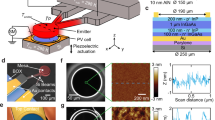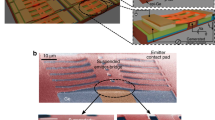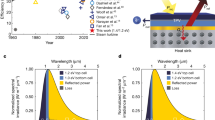Abstract
The most common approaches to generating power from sunlight are either photovoltaic, in which sunlight directly excites electron–hole pairs in a semiconductor, or solar–thermal, in which sunlight drives a mechanical heat engine. Photovoltaic power generation is intermittent and typically only exploits a portion of the solar spectrum efficiently, whereas the intrinsic irreversibilities of small heat engines make the solar–thermal approach best suited for utility-scale power plants. There is, therefore, an increasing need for hybrid technologies for solar power generation1,2. By converting sunlight into thermal emission tuned to energies directly above the photovoltaic bandgap using a hot absorber–emitter, solar thermophotovoltaics promise to leverage the benefits of both approaches: high efficiency, by harnessing the entire solar spectrum3,4,5; scalability and compactness, because of their solid-state nature; and dispatchablility, owing to the ability to store energy using thermal or chemical means6,7,8. However, efficient collection of sunlight in the absorber and spectral control in the emitter are particularly challenging at high operating temperatures. This drawback has limited previous experimental demonstrations of this approach to conversion efficiencies around or below 1% (refs 9, 10, 11). Here, we report on a full solar thermophotovoltaic device, which, thanks to the nanophotonic properties of the absorber–emitter surface, reaches experimental efficiencies of 3.2%. The device integrates a multiwalled carbon nanotube absorber and a one-dimensional Si/SiO2 photonic-crystal emitter on the same substrate, with the absorber–emitter areas optimized to tune the energy balance of the device. Our device is planar and compact and could become a viable option for high-performance solar thermophotovoltaic energy conversion.
This is a preview of subscription content, access via your institution
Access options
Subscribe to this journal
Receive 12 print issues and online access
$259.00 per year
only $21.58 per issue
Buy this article
- Purchase on Springer Link
- Instant access to full article PDF
Prices may be subject to local taxes which are calculated during checkout




Similar content being viewed by others
Change history
14 May 2015
In this Letter, the scaling factor relating the optimal emitter temperature to the photovoltaic bandgap energy was approximated using Planck's distribution expressed in units of wavelength. For a discussion of scaling factors, see the Addendum in the PDF version.
References
Schwede, J. W. et al. Photon-enhanced thermionic emission for solar concentrator systems. Nature Mater. 9, 762–767 (2010).
Kraemer, D. et al. High-performance flat-panel solar thermoelectric generators with high thermal concentration. Nature Mater. 10, 532–538 (2011).
Harder, N.-P. & Würfel, P. Theoretical limits of thermophotovoltaic solar energy conversion. Semicond. Sci. Technol. 18, 151–156 (2003).
Shockley, W. & Queisser, H. J. Detailed balance limit of efficiency of p-n junction solar cells. J. Appl. Phys. 32, 510–519 (1961).
Rephaeli, E. & Fan, S. Absorber and emitter for solar thermo-photovoltaic systems to achieve efficiency exceeding the Shockley–Queisser limit. Opt. Express 17, 15145–15159 (2009).
Chan, W. R. et al. Toward high-energy-density, high-efficiency, and moderate-temperature chip-scale thermophotovoltaics. Proc. Natl Acad. Sci. USA 110, 5309–5314 (2013).
Datas, A., Chubb, D. L. & Veeraragavan, A. Steady state analysis of a storage integrated solar thermophotovoltaic (SISTPV) system. Sol. Energ. 96, 33–45 (2013).
Chubb, D. L., Good, B. S. & Lowe, R. A. Solar thermophotovoltaic (STPV) system with thermal energy storage. AIP Conf. Proc. 358, 181–198 (1996).
Datas, A. & Algora, C. Development and experimental evaluation of a complete solar thermophotovoltaic system. Prog. Photovolt. Res. Appl. 21, 1025–1039 (2012).
Vlasov, A. S. et al. TPV systems with solar powered tungsten emitters. AIP Conf. Proc. 890, 327–334 (2007).
Yugami, H., Sai, H., Nakamura, K., Nakagawa, H. & Ohtsubo, H. Solar thermophotovoltaic using Al2O3/Er3Al5O12 eutectic composite selective emitter. IEEE Photovolt. Spec. Conf. 28, 1214–1217 (2000).
Chubb, D. L. Fundamentals of Thermophotovoltaic Energy Conversion (Elsevier, 2007).
Siegel, R. & Howell, J. R. Thermal Radiation Heat Transfer (Hemisphere, 1981).
Florescu, M. et al. Improving solar cell efficiency using photonic band-gap materials. Sol. Energ. Mat. Sol. C 91, 1599–1610 (2007).
Bermel, P. et al. Design and global optimization of high-efficiency thermophotovoltaic systems. Opt. Express 18, A314–A334 (2010).
Ghebrebrhan, M. et al. Tailoring thermal emission via Q matching of photonic crystal resonances. Phys. Rev. A 83, 033810 (2011).
Rinnerbauer, V. et al. Recent developments in high-temperature photonic crystals for energy conversion. Energy Environ. Sci. 5, 8815–8823 (2012).
Rinnerbauer, V. et al. High-temperature stability and selective thermal emission of polycrystalline tantalum photonic crystals. Opt. Express 21, 11482–11491 (2013).
De Zoysa, M. et al. Conversion of broadband to narrowband thermal emission through energy recycling. Nature Photon. 6, 535–539 (2012).
Celanovic, I., Jovanovic, N. & Kassakian, J. Two-dimensional tungsten photonic crystals as selective thermal emitters. Appl. Phys. Lett. 92, 193101 (2008).
Wu, C. et al. Metamaterial-based integrated plasmonic absorber/emitter for solar thermo-photovoltaic systems. J. Opt. 14, 024005 (2012).
Yang, Z-P., Ci, L., Bur, J. A., Lin, S-Y. & Ajayan, P. M. Experimental observation of an extremely dark material made by a low-density nanotube array. Nano Lett. 8, 446–451 (2008).
Yang, Z-P. et al. Experimental observation of extremely weak optical scattering from an interlocking carbon nanotube array. Appl. Opt. 50, 1850–1855 (2011).
Shi, H., Ok, J. G., Baac, H. W. & Guo, L. J. Low density carbon nanotube forest as an index-matched and near perfect absorption coating. Appl. Phys. Lett. 99, 211103 (2011).
Wang, C. A. et al. High-quantum-efficiency 0.5 eV GaInAsSb/GaSb thermophotovoltaic devices. Appl. Phys. Lett. 75, 1305–1307 (1999).
Dashiell, M. W. et al. Quaternary InGaAsSb thermophotovoltaic diodes. IEEE Trans. Electron. 53, 2879–2891 (2006).
Chan, W. et al. Modeling low-bandgap thermophotovoltaic diodes for high-efficiency portable power generators. Sol. Energ. Mater. Sol. C 94, 509–514 (2010).
Posthuma, N. E., van der Heide, J., Flamand, G. & Poortmans, G. Emitter formation and contact realization by diffusion for germanium photovoltaic gevices. IEEE Trans. Electron. 54, 1210–1215 (2007).
Nessim, G. D. et al. Low temperature synthesis of vertically aligned carbon nanotubes with electrical contact to metallic substrates enabled by thermal decomposition of the carbon feedstock. Nano Lett. 9, 3398–3405 (2009).
Acknowledgements
This work is supported as part of the Solid-State Solar Thermal Energy Conversion (S3TEC) Center, an Energy Frontier Research Center funded by the US Department of Energy, Office of Science, Office of Basic Energy Sciences under DE-FG02-09ER46577. A.L. acknowledges the support of the Martin Family Society, the MIT Energy Initiative and the National Science Foundation GRF. Y.N. acknowledges support from the Basic Science Research Program through the National Research Foundation of Korea (NRF) funded by the Ministry of Science, ICT & Future Planning (no. 2012R1A1A1014845). The authors thank C. Wang from Lincoln Laboratory for providing the InGaAsSb cells; H. Mutha, D. Li and C.V. Thompson's group (for CNT growth); N. Miljkovic, T. Humplik, J. Sack, D. Preston and the Device Research Lab (for SEMs, experimental set-up); and D. Kraemer, M. Luckyanova, G. Chen and the Nanoengineering group (for advice).
Author information
Authors and Affiliations
Contributions
All authors contributed extensively to this work. A.L., D.M.B. and Y.N. envisioned and implemented the experimental studies. A.L. and D.M.B. fabricated the absorber, executed the experiments and wrote the paper. W.R.C. designed and fabricated the emitter. I.C., M.S. and E.N.W. supervised and guided the project.
Corresponding author
Ethics declarations
Competing interests
The authors declare no competing financial interests.
Supplementary information
Supplementary information
Supplementary Information (PDF 994 kb)
Rights and permissions
About this article
Cite this article
Lenert, A., Bierman, D., Nam, Y. et al. A nanophotonic solar thermophotovoltaic device. Nature Nanotech 9, 126–130 (2014). https://doi.org/10.1038/nnano.2013.286
Received:
Accepted:
Published:
Issue Date:
DOI: https://doi.org/10.1038/nnano.2013.286
This article is cited by
-
Promising thermal photonic management materials for sustainable human habitat
Nano Research (2024)
-
Polarization rotation and reflection/absorption control using metal-VO2-metal switchable plasmonic metasurface at infrared regime
Optical and Quantum Electronics (2023)
-
Design and analysis of electrothermal metasurfaces
Frontiers in Energy (2023)
-
Random laser performance by magneto-plasmonic nanoparticles
Journal of Optics (2023)
-
High-index-contrast photonic structures: a versatile platform for photon manipulation
Light: Science & Applications (2022)



